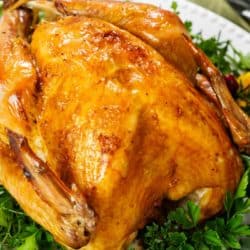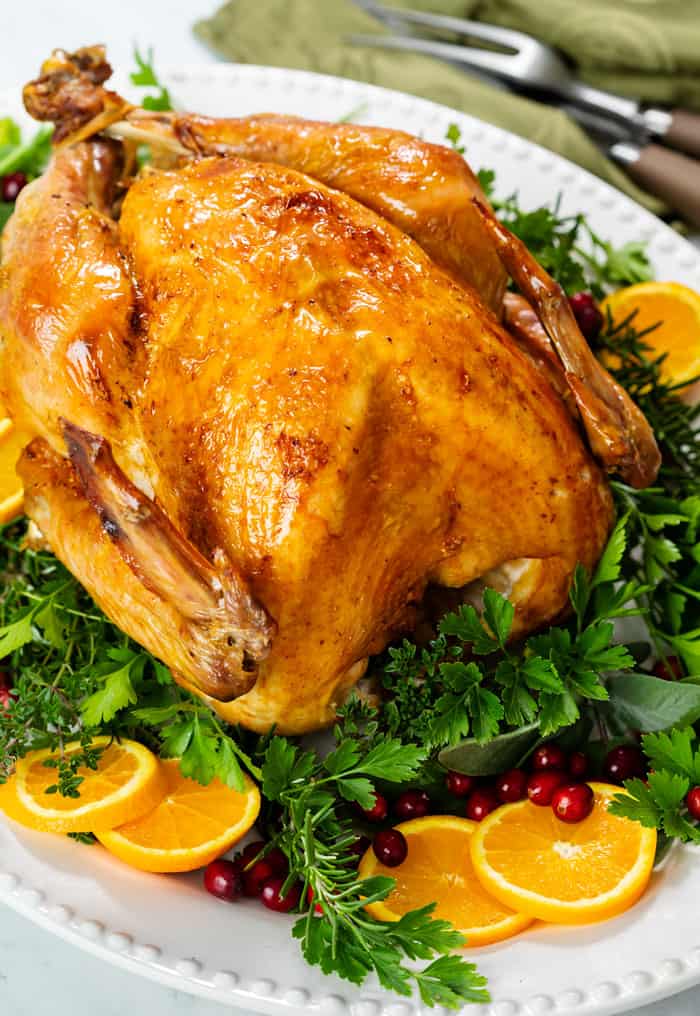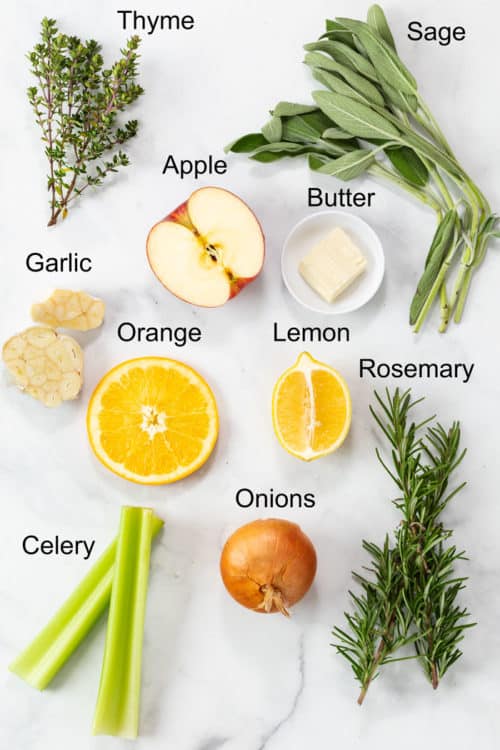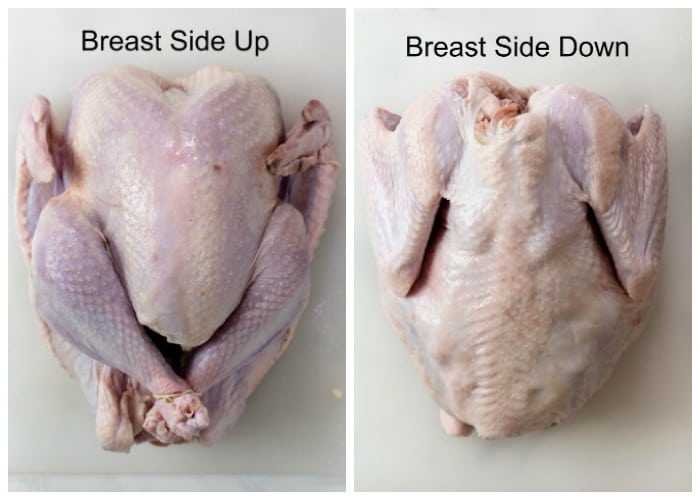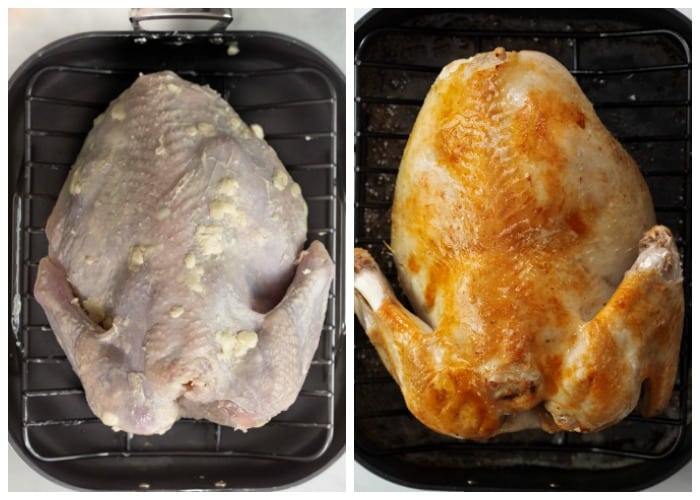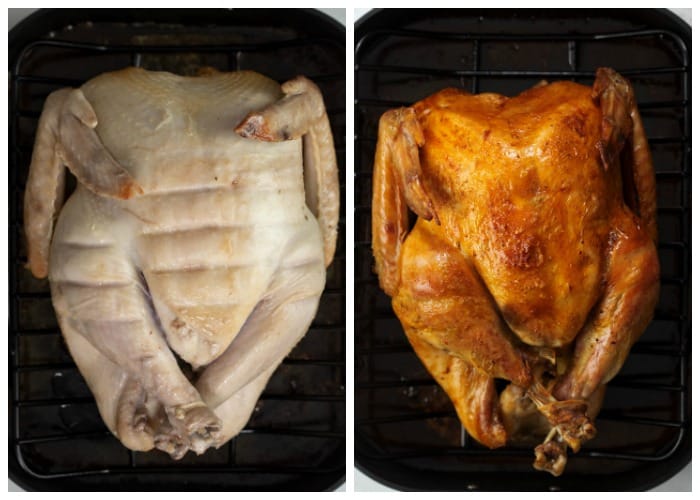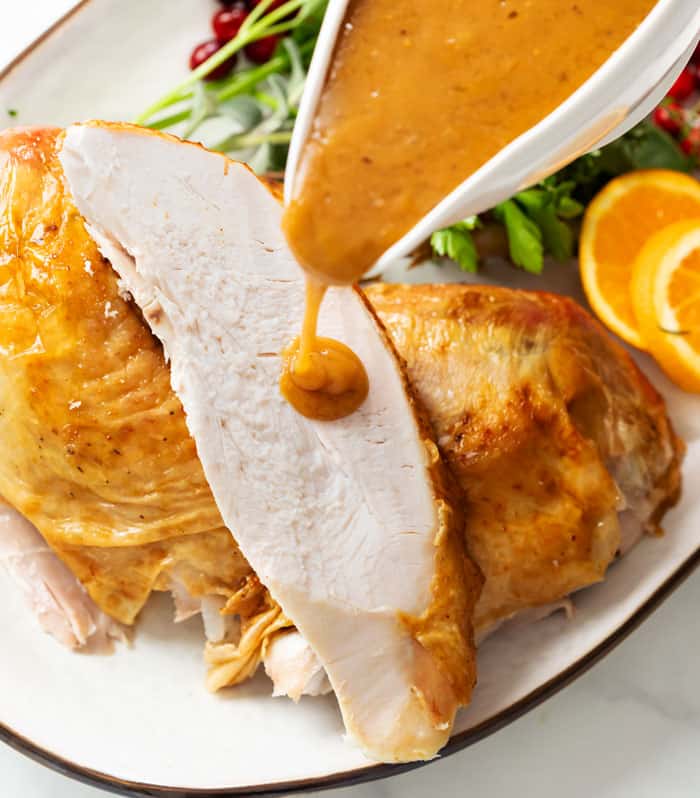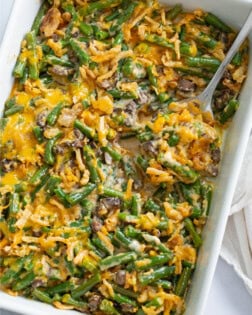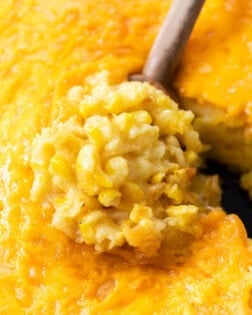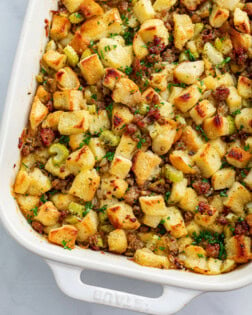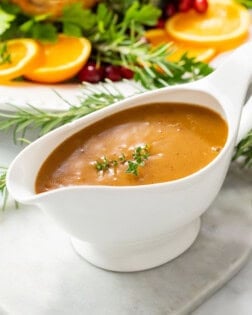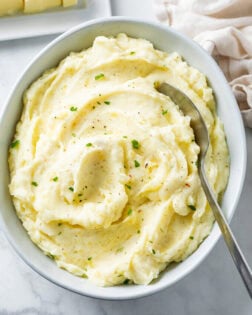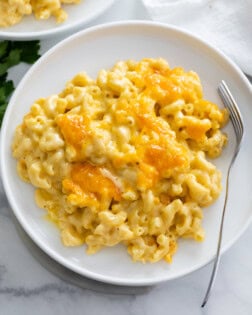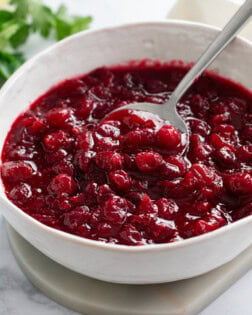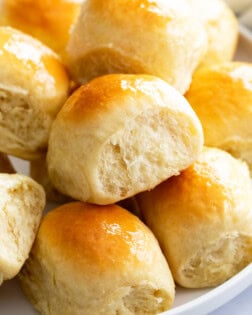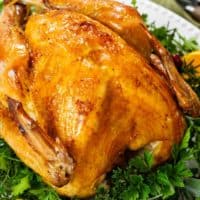Be sure to try my Green Bean Casserole , Mashed Potatoes, Sausage Stuffing, Cranberry Sauce, and Dinner Rolls next!
Roast Turkey Recipe
Let me start with this: this roast turkey recipe is not that hard. I have a lot of information in this post because there are a lot of questions that come up when it comes to turkey. The reason for that, I believe, is that it can be difficult to determine the best way to roast a large piece of meat that is prone to drying out and has different cuts that are best cooked to different temperatures. I’m here to answer these questions and break down the BEST way to roast a turkey that leaves you with perfectly cooked white and dark meat and that’s juicy and flavorful. (And brown and crispy on the outside.) Let’s start with a quick overview:
Key Points Before We Begin:
Choose a fresh (not frozen) turkey with little to no salt solution added if you plan on brining. Dry Brining = ULTIMATE results. Juicy inside, extra brown and crispy outside. Easier than a wet brine. Start roasting breast-side-down at 425°, finish roasting breast side up at 350°. This gives the dark meat a head start while protecting the breast and keeping it moist. Dark meat is better at 175°-180°, breast meat is best at 165°. No larger than a 15-pound turkey. Otherwise roast 2 turkeys. Factor 1 lb. turkey per person. Use a meat thermometer! (A real one. Not the red pop-up.) Preferably with 2 probes. I’ve linked to one at the bottom of this post as well as other tools you’ll need. Let it rest 20-30 minutes before you slice.
How To Pick a Turkey
Don’t get an overly large turkey: It’s much better to roast 2 smaller turkeys than one very large turkey, 15 pounds should be the max size that you choose. Make sure you’re selecting a whole turkey and don’t accidentally purchase a very large turkey breast. (I’ve done that before.😂) If you plan on brining your turkey: Get fresh turkey instead of a frozen one as those typically have a salt solution already injected into it. Purchase the turkey 2-3 days prior to roasting to allow sufficient brining time. If not brining: Ensure you have enough time for your turkey to defrost if purchasing a frozen turkey. (See section below for defrosting information)
How Much Turkey Per Person
You’ll want factor in one pound of turkey per person. If you love leftover turkey, plan on 1 ½ pounds of turkey per person.
How to Defrost a Turkey
Defrosting in the refrigerator is ideal. You need 24 hours of defrosting time for every 4 pounds of turkey. Place the turkey in a roasting pan to catch any liquid that leaks as it defrosts. OR submerge the turkey in cold water, it will take 30 minutes per pound and you’ll want to change out the water every 30 minutes.
Prepare the Turkey for Roasting
Brine it (A few days ahead of time. See next section below) Remove neck and the giblets from the cavity. I like to gently boil them in about 2 cups of water (pouch removed), while the turkey roasts. Once it gets down to 1/3 cup, I save that liquid and add it to my drippings to make gravy. Pat completely dry. Allow the turkey to sit out and come close to room temperature before roasting for even cooking. Placing a cold turkey in the oven can dry out the outside before the inside has a chance to finish cooking.
Brining
Turkey is a type of meat that can be prone to drying out. A brine helps keep it juicy and adds flavor. It can be in a dry or liquid form and contains salt which penetrates through the meat and not only gives it flavor, but breaks down the protein fibers and makes it juicy and tender. To learn all about it and check out some brining recipes, check out my post on how to brine a turkey.
What to Stuff a Turkey With
All of the following ingredients are great for stuffing a turkey and add a wonderful aroma to the kitchen: Butter, Thyme, Sage, Rosemary, Garlic, Apples, Lemon, Oranges, Celery, Onions. If you plan on stuffing your turkey with a breading mixture (like my delicious sausage stuffing), it will need to reach 165°, which happens after the turkey is already done (since it bakes right in the middle). To avoid drying out your turkey, remove the stuffing from the turkey after it’s done roasting and transfer it to a casserole dish. Bake at 350° until it reaches 165°.
Trussing
Tying the turkey legs with kitchen twine (or “trussing”), is optional, I like to do it to keep the legs secured in place. Some Chefs are against trussing as it can prevent excess air from circulating around the thighs as they cook, because they’re pressed up against the breast.
Make Sure there is Airflow in the Pan
Make sure there is airflow underneath the turkey when you roast, the air circulation makes the skin nice and crispy. You don’t want the turkey to sit in it’s own juices. If you don’t have a roasting pan with a rack: Let the turkey sit on top of vegetables like carrots, celery, onions, and garlic. (This makes the vegetables taste great too!)
Basting
Basting a turkey is to spoon, brush, or pour liquid over it throughout the cooking process to keep it moist. The liquid can be drippings from the pan, or chicken/turkey broth. If you don’t have drippings to work with during the beginning of the roasting process, use some broth at first, the switch to pan drippings. If desired, you may baste your turkey every 30 minutes. If you brined your turkey, you can do it in fewer increments.
What Temperature to Roast a Turkey
For this recipe, we start breast-side-down at 425° and finish breast-side-up at 350°:
This is the best way to crisp up the bottom and allow the thighs (the dark meat), to get a head start in cooking. Dark meat is much more tender and flavorful if cooked to a higher temperature (around 175°-180°) while the breast is best at 160°-165°. This cooking method achieves that perfectly.
How to Roast it
Note: See recipe card below this post for ingredient quantities and full instructions. Remove the neck and giblets and pat dry. Add 3/4 cup chicken broth to the bottom of the roasting pan. Rub the turkey generously with butter and olive oil and place it breast-side-down in the pan. (Salted butter is fine for an unbrined turkey. Use unsalted for a brined turkey.) Roast the turkey in a 425° oven for 45 minutes. Rotate the pan 180° halfway through.
Decrease heat to 350° and carefully flip the turkey, breast-side-up. Add another 3/4 cup chicken broth to the roasting pan and baste the turkey with it. Roast until the breast reaches 160°, then pull from the oven and let it sit for 20-30 minutes prior to serving. It will increase to the necessary 165° during this time.
How Long to Roast Turkey
The general rule of thumb is 13 minutes per pound at 350° for an unstuffed turkey, and 15 minutes per pound for a stuffed turkey. Note: Brined turkeys will cook faster. Cooking the turkey at a higher temperature first also decreases the cooking time to about 10 minutes per pound. The turkey is done when the thick part of breast meat reaches 165°. Important Note: Most sources measure the temperature of the thick part of the thigh, but by cooking the turkey breast-side-down for the first 45 minutes, we’re allowing the thighs to get a head start and thus will reach 165° sooner than the breast. This is preferred because 175°-180° is ideal for dark meat, 165° is ideal for breast meat. This gives you the best result all-around for white and dark meat. A visual indicator that the turkey is done is if the legs wiggle easily and the juices run clear when you press the thigh into the body. Pull the turkey from the oven when the breast hits 160° and let it rest for 20-30 minutes. The meat will continue to heat and reach the necessary 165° temperature. Pro Tip: As the turkey nears completion, check on the color and increase heat to 500° if additional browning is desired.
Let it Rest (without foil)
Let the turkey rest for a full 20-30 minutes prior to serving to let the meat fully absorb the warm juices. Cutting right into the turkey will cause the juice to run out everywhere. Resist the urge to keep the turkey warm by topping it with foil. The steam will create condensation and we want our skin to stay crispy! The turkey will remain warm on the inside and will even continue to cook a bit, no need for foil.
My Secret Weapon For Even Browning
This heating gun (affiliate link) is a handy way to add a bit of additional browning on any uneven spots without the risk of drying it out by broiling it in the oven for too long. Dry brining the turkey dries out the skin and makes it nice and brown, but if you skipped this step, this trick can help. 😉 Use it while the turkey is still in the roasting pan to catch any additional drippings. Use this tool with caution and note that the end stays hot for a bit, give it time to cool down.
What To Make With Leftover Turkey
Turkey Soup Homemade Stock Chicken and Rice Soup (with turkey, of course!) Chicken Vegetable Soup Chicken Tortellini Soup Chicken Broccoli Rice Casserole Chicken Tetrazzini Creamy Chicken Tortilla Soup Chicken Enchilada Soup
More for Your Holiday Table
Check out all of my Thanksgiving recipes here and my Christmas recipes here!
Meat Thermometer– The single most important thing to have. Use one probe for the thigh, one for the breast. Never rely on the red popping thermometer. Ove Gloves- Makes it easy to grip the turkey and flip it over easily while protecting your hands. (Be sure to wash them after handling the turkey.) Roasting Pan– I use All-clad which is a little more expensive but super high quality and you’ll have it forever. Kitchen Twine, Turkey Baster & Poultry Lifters Unsalted Chicken Broth- to add to your drippings if they taste too salty to make gravy with. Gravy Boat– This one keeps the gravy warm!
Check out all of my Thanksgiving and Christmas recipes!
